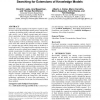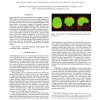245 search results - page 39 / 49 » STEPS - An Approach for Human Mobility Modeling |
ATAL
2003
Springer
14 years 22 days ago
2003
Springer
In this paper, we introduce a toolkit called SceneMaker for authoring scenes for adaptive, interactive performances. These performances are based on automatically generated and pr...
KCAP
2003
ACM
14 years 22 days ago
2003
ACM
Electronic concept mapping tools empower experts to play an active role in the knowledge capture process, and provide a medium for building richly connected multimedia knowledge m...
IPM
2011
12 years 11 months ago
2011
In recent years, new semistatic word-based byte-oriented text compressors, such as Tagged Huffman and those based on Dense Codes, have shown that it is possible to perform fast d...
ICCV
2003
IEEE
14 years 9 months ago
2003
IEEE
The problem considered in this paper is the fully automatic construction of panoramas. Fundamentally, this problem requires recognition, as we need to know which parts of the pano...
ISBI
2011
IEEE
12 years 11 months ago
2011
IEEE
Segmenting brain from non-brain tissue within magnetic resonance (MR) images of the human head, also known as skull-stripping, is a critical processing step in the analysis of neu...


